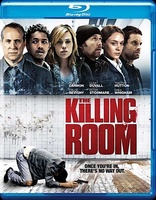The Killing Room Blu-ray Movie
HomeThe Killing Room Blu-ray Movie 
Experiment Killing RoomVivendi Visual Entertainment | 2009 | 93 min | Rated R | Aug 10, 2010
Movie rating
6.2 | / 10 |
Blu-ray rating
| Users | 0.0 | |
| Reviewer | 4.0 | |
| Overall | 4.0 |
Overview
The Killing Room (2009)
Four strangers are recruited as volunteers in a scientific research study. But they soon find that they are pawns in a classified government program to determine the breaking point of the human mind. As the experiments are conducted with each unwilling participant, the sterile white room becomes a horrible nightmare where the endgame is survival itself.
Starring: Nick Cannon, Clea DuVall, Chloë Sevigny, Timothy Hutton, Peter StormareDirector: Jonathan Liebesman
| Thriller | Uncertain |
| Mystery | Uncertain |
| Drama | Uncertain |
Specifications
Video
Video codec: MPEG-4 AVC
Video resolution: 1080p
Aspect ratio: 2.35:1
Original aspect ratio: 2.39:1
Audio
English: DTS-HD Master Audio 5.1
Subtitles
None
Discs
25GB Blu-ray Disc
Single disc (1 BD)
Playback
Region A (locked)
Review
Rating summary
| Movie | 4.0 | |
| Video | 4.0 | |
| Audio | 4.0 | |
| Extras | 0.0 | |
| Overall | 4.0 |
The Killing Room Blu-ray Movie Review
This taut and disturbing thriller may be totally improbable, but that doesn't keep it from being extremely disquieting.
Reviewed by Jeffrey Kauffman August 1, 2010When then-First Lady Nancy Reagan launched her famous “Just say no!” campaign against drugs in the 1980’s, she may have conveniently forgotten (or, indeed, never really have known) that the U.S. Government had itself been a “pusher” of sorts, proffering illicit substances to various unsuspecting folk and then gathering supposedly “scientific” data on how they reacted to taking an unexpected “trip.” The most famous of these efforts was the covert operation known as MK-ULTRA, which became momentarily notorious in the mid-1970’s when Congress attempted to investigate it, only to find out that then-CIA Director Richard Helms had destroyed all documentation about the program the year before the investigation began. The CIA insisted later that MK-ULTRA had been abandoned, though stories continued to leak out about both the devastating effects of its prior use (one famous incident involved a CIA agent leaping to his death from a skyscraper, which his family insists to this day was done under the influence of LSD secretly administered to him by his bosses), as well as it supposed continuation within the secretive bowels of the CIA hierarchy. The Killing Room starts with a textual precursor about MK-ULTRA, and then takes off on a chilling little detour that may not involve actual drug use, but which plays on theories of Skinner Boxes and radical behavior modification, as well as analogs to cellular extinction, all wrapped up in a denouement which paints the horror in the larger picture of the War on Terror and how exactly we in the West are going to deal with the irrationalities of the Jihadists.
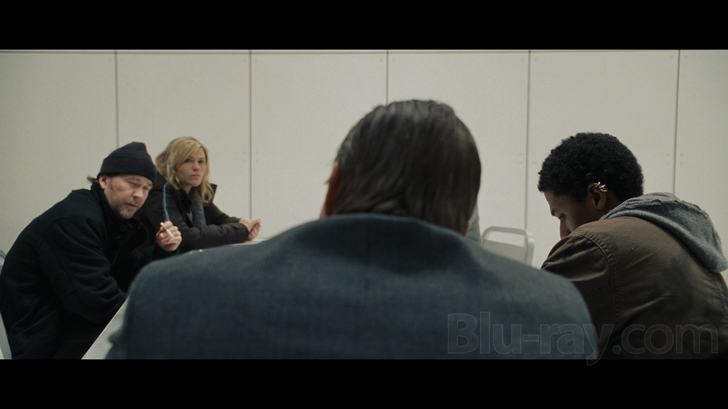
Dr. Phillips explains to his subjects that they'll be paid $250. Of course he leaves out the part about them being killed one by one.
The Killing Room has one brief, shining moment out of doors, as neophyte researcher Emily Reilly (Chloë Sevigny) shows up at a labyrinthine facility, where she is quickly escorted indoors and comes under the aegis of the more than slightly spooky Dr. Phillips (Peter Stormare), who is interviewing her for a position at his research operation. Phillips explains to Reilly that what she’s about to witness on tapes he loads (strangely into old school reel to reel players) “don’t exist,” at which point Reilly watches as four disparate people are led into a sanitary white room where the only furniture is a table and some chairs, all bolted to the floor. High above are some one-way windows where it’s not hard to imagine everything in the pristine environment is being observed and analyzed. We have a punkish young woman (Clea DuVall), a young family man (Shea Whigham), a sort of mysterious guy who’s evidently taken part in similar experiments before (Timothy Hutton), and a very young, evidently homeless, African American (Nick Cannon). These four start by looking through an insanely long questionnaire, making a few disparaging comments about it, and then slowly but surely making it through such questions as: “The ship is sinking. I save: a) Them; b)Myself; c)No one.” Suddenly Dr. Phillips enters, no longer sporting the thick Eastern European accent he exhibited with Reilly, but instead a quasi-Southern drawl, and he tells the four that they’ll be there for eight hours and each will be paid $250 at the conclusion of the day. Suffice it to say that what he doesn’t mention is each of them will be killed, or at least threatened with death, as this radical behavior research is carried out. In fact when the first death follows quickly after Phillips’ putative explanation, it is so completely shocking and unexpected that the audience is quickly drawn into the terror and disorientation that the three survivors suddenly feel. After the taped review ends, Reilly discovers that she’s actually in the location of this behavior experiment, which has actually been playing out in the darkened room in front of her just a few hours before her arrival. She then discovers that she’s to take part in the next phase of the day.
This is a film which plays upon fears of claustrophobia, not being in control, and having no idea what is expected or how to properly respond to various events and stimuli. Though the film has an at times oddly dispassionate approach, especially when it’s told through the observer’s eyes from Reilly’s point of view, it also wants us to feel the terror of the locked room participants, especially after the first killing has taken place.. Director Jonathan Liebesman does exceptional work crafting a suffocating environment as he captures the increasing panic of the three participants who survive the initial trial, and then find themselves attempting to understand exactly what they’ve evidently signed up for. The Killing Room virtually drowns in a sea of paranoia and subterfuge, but it’s to Liebesman’s credit (as well as scenarists Gus Krieger and Ann Peacock) that despite some clunky dialogue, the audience is never quite sure exactly what’s going on or whose point of view we’re actually supposed to be identifying with. Though that lack of focus has sunk many a larger-budgeted film than The Killing Room, here it actually works to this movie’s benefit, keeping the audience as unsettled as our three putative heroes.
Once The Killing Room moves to its endgame, and some of the motives and actual raisons d’etre for the project are made clear, while some may throw up their hands in disgust at the political posturing Krieger and Peacock proffer, the fact is it ties in neatly with Reilly’s “interview” and one devastating decision she makes which ultimately moves the film forward to its rather Twilight Zone-esque coda. If The Killing Room has some blatant flaws in logic, it at least stays true to its own inherent principles, never straying from the topsy-turvy research environment it sets up. The performances here are all spot on, with all of the room’s actors growing increasingly panic-stricken, resorting to various improvised rationales to help them make it out alive. Sevigny is surprisingly buttoned down in her role, especially when one remembers her flamboyant turns in such disparate fare as Boys Don’t Cry and (lest we forget) Brown Bunny, and she brings a surprising amount of gravitas to the role that, for better or worse, becomes a stand-in for the audience as the film progresses.
Though some may find some connections in The Killing Room to the Saw franchise, the fact is the “game” here is decidedly more serious in its socio-political implications than the “mere” sociopathology of Saw. Liebesman is proving himself a very able director when it comes to ferreting out the nooks and crannies of the human psyche under trying conditions. This is a film that has a limited scope and ambitions, but which delivers some fairly devastating emotional results within those limitations.
The Killing Room Blu-ray Movie, Video Quality 
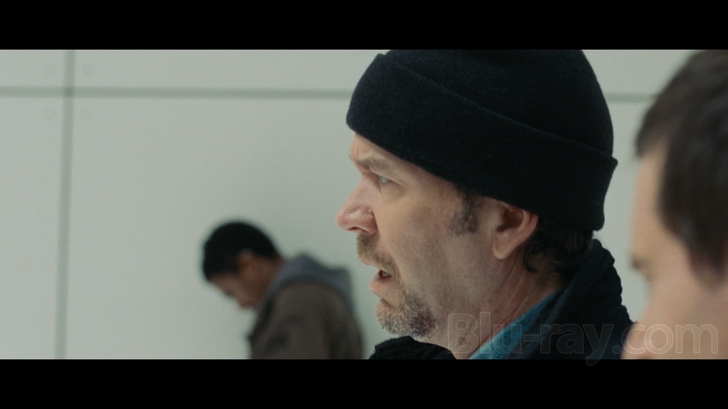
The Killing Room was obviously shot on a miniscule budget, and director Liebesman is going for a low-fi verité look here, so expecting this Blu-ray's AVC encoded 1080p image (in a 2.35:1 aspect ratio) to have the pristine digital beauty of a summer blockbuster is unfair and unwise. The Killing Room features a lot of fluorescently lit footage, which gives the film a blown out, low contrast look that can make the image appear softer than it actually is. Colors here also tend to be muted, with the exception of the sprays of blood, which contrast brilliantly against the cold, hard whiteness of the room where the experiment subjects find themselves held captive. In fact in terms of the pure contrast between these whites and the surrounding blacks of the observation room, contrast is really quite excellent, once it's removed from the garish lighting scheme employed to deliberate purpose. If you give in to The Killing Room's "you are there" ethos, which is certainly what Liebesman is aiming for, this Blu-ray reproduces the claustrophobic, ugly world of the white "jail" with devastating accuracy.
The Killing Room Blu-ray Movie, Audio Quality 
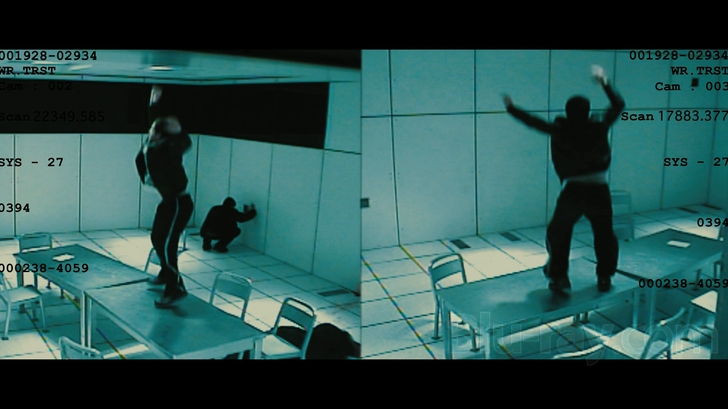
While The Killing Room's lossless DTS-HD Master Audio 5.1 mix is fine in and of itself, it has a couple of distressing elements, not the least of which is Storamire's absolutely indecipherable accent in the early scenes, and the echoey ambience of the experiment room itself, which leaves the subjects' panicked whispers awash in muddiness. This normally wouldn't be a problem, except that this Blu-ray offers no subtitles to help the audience get through the morass. The fault here can't be lain entirely at the actual soundtrack's feet, but in the recording and mixing process, not to mention the evident lack of looping, which could have helped to clear up some of these issues. All of this said, for the most part the track is clear and crisp, with some excellent use of sound effects which help to heighten the claustrophobic terror of being locked in a room. Surround channels are well utilized for the techno-babble which spills from unseen observers throughout the film, though that babble itself may annoy some listeners after a while.
The Killing Room Blu-ray Movie, Special Features and Extras 
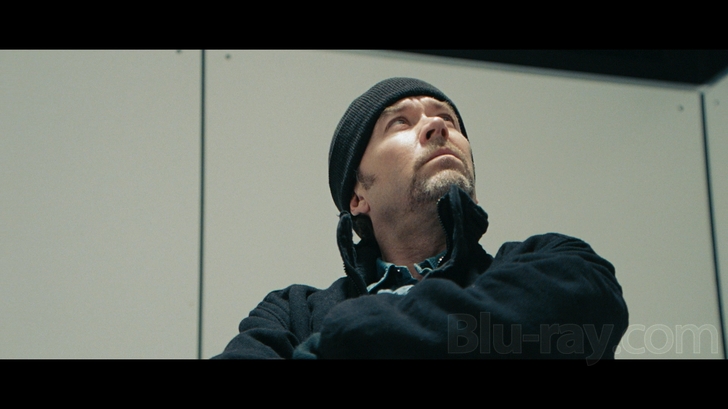
There are no supplements on this Blu-ray. A documentary on MK-ULTRA and other mind control techniques would have been illuminating.
The Killing Room Blu-ray Movie, Overall Score and Recommendation 

The Killing Room may play out as a "very special Twilight Zone," but its political edge, delivered in its final moments, at least proves that its makers weren't taking any of the horror lightly. One way or the other, this is a disturbing little thriller which gets under the skin and festers uneasily. If the denouement is both shocking and frankly silly, getting there is a nightmare journey that isn't quickly forgotten. Recommended.
Similar titles
Similar titles you might also like

Proxy
2013

Winchester
2018

When the Bough Breaks
2016

Saw VI
Unrated Director's Cut
2009

Stonehearst Asylum
Eliza Graves
2014

A Cure for Wellness
2016

Return to Sender
2015

Saw 4K
2004

Red Lights
Combo
2012

Retreat
2011

Freaks
2018

Alice, Sweet Alice 4K
Communion / Holy Terror | Limited Edition
1976

I Know Who Killed Me
2007

Dream House
2011

The Snowman
2017

The Ninth Configuration
Twinkle, Twinkle, "Killer" Kane
1980

6 Souls
Shelter
2010

The Skeleton Key
2005

Tell-Tale
2009

Irresistible
Slipcover in Original Pressing
2006
